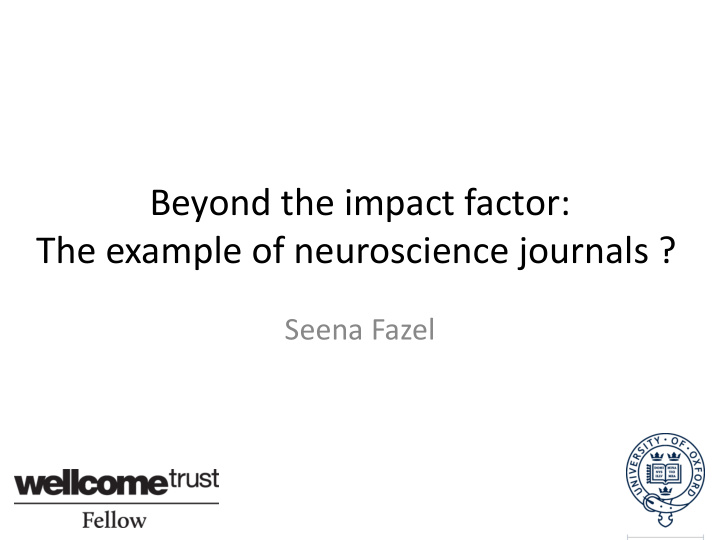



Beyond the impact factor: The example of neuroscience journals ? Seena Fazel
Overview – measures of impact • Individual • Institutional • Journal
Why it matters • Judgements made on individuals and institutions • BRC application and theme leaders • h-index used for grant applications • REF requires 4 papers since January 2008
Individual measures • Total citations • Citations/paper • h-index = a scientist has an index h if his or her Np papers have at least h citations each and the other (Np- h) papers have ≤h citations each • But favours seniority, research field sensitive, no consideration of extent of your contribution • m-index = h/n, where n is the academic age (number of years since first paper) • v-index is the m index divided by p(m/p) where p is the percentage time spent on research
Other individual measures • g-index – credit for highly cited articles • Contemporary h-index (cf. Google scholar over last 5 years) • Individual h-index (h-index divided by the mean number of researchers in the h publications) • i10-index – number of papers with >10 citations
Abuses • Inflated self-citation • Citation amnesia • Unholy alliances • Salami slicing
But…
Journal IPs • Thomson Reuters JIP • Google h5-index • Elsevier Impact per Publication (IPP) • Source Normalised Impact per Paper (SNIP) • SCImago Journal Rank (SJR)
False idol? Impact factor is influenced by: • Citation behaviour of researchers • Length of article (longer the better) • Accessibility of articles (open access) • Errors in citation counting • Publication frequency • Research field • Publication lag (submission to publication) • Limitations of SCI database • Fashions, language
Other ways to judge an paper • Total citations • Citations/year • (Citations/year)/author • Downloads/reads/most viewed lists • Editorials/commentaries/press releases
Advice to an editor
Fazel, EBMH 2015
How to improve your impact? • General journals? • Niche fields • Buildings • Atypical combinations
What doesn’t work?
General journals • General interest • Public health angle • Simple message • Potential to change practice • From PLoS Medicine: “ We publish important studies across all medical disciplines that are of wide general interest. Hence, we are looking for papers that will provide a substantial new insight into the pathogenesis of disease, with a clear path to clinical application, or a substantial advance in management or public health policy .”
EU Survey of 11,000 academics • Although time spent working on research was unsurprisingly linked with research productivity, "teaching or administrative workloads were not found to be predictors across any of the 12 countries ,” • Job satisfaction and institutional factors such as "managerial support, managerial style (communication and collegiality) and infrastructural support related to research" seemed to matter only in a small minority of countries, while both age and gender were dwarfed by other factors. • Far more significant in predicting whether someone was likely to generate a steady stream of papers were "a stated preference for research over teaching and involvement in the wider research community .” • Such involvement, as witnessed by "peer reviewing, membership of scientific committees and editorial positions," turned out to be "the only predictor evident across all countries and the strongest predictor for publication productivity in eight countries." National or international collaborations were also important factors in most countries. Ref: EURODOC survey, 2012
Summary • Consider multiple measures of impact • Work in atypical combinations in buildings that promote frequent spontaneous interactions • Publish in journals that reduce research waste • Collaborations comfortable but not too comfortable
Recommend
More recommend